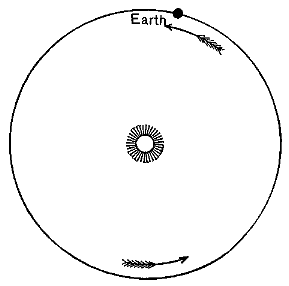 |
Any one who thinks will see that this annual change of the seasons depends in some way on the sun; that the season is hot or cold, and the days long or short, according to the apparent path of the sun in the heavens. We have now to show that the changes of the seasons arise from the earth making an annual revolution around the sun. Thus the earth has two motions, its rotation on its own axis, and its revolution around the sun. The first produces day and night, the second summer and winter. To conceive the combined effect of these two revolutions is a task which requires some thinking. We have two things to consider, -- the actual motion of the earth, and the apparent motion of the sun as we seem to see it.
If we could fly upward in a direction near that of the earth’s axis to a distance of a thousand million miles, and then look back, we should see the earth and a number of other bodies forming, as it were, a little family far distant from all other heavenly bodies. The largest and brightest of those bodies would be the sun. At various distances and directions from the sun we should see eight or more smaller bodies looking like stars. If we watched long enough, we should see that those seeming stars were all in motion around the sun, each one keeping nearly, but not exactly, at the same distance from it during its course. The nearest would complete its circuit in about three months, while the most distant would take more than 160 years. These small starlike bodies are called planets.
The paths in which the planets perform their courses round the sun are called their orbits.
 |
One of these planets is the earth on which we dwell. It is the third in the order of distance from the sun, and, as we have said, it requires a year to complete its circuit around the sun. It would be more exact to say that the time required for it to complete its circuit is what we call a year.
Besides the eight planets which we have described there are a number of smaller bodies going round the sun which we shall describe hereafter. This whole family of bodies is called the solar system. It is so called because the sun is the great central body on which all the others depend, and to which they all do homage, so to speak.
The distance of the earth from the sun has been determined in a number of different ways. According to the latest researches it is very nearly 93,000,000 miles; we scarcely know whether a little greater or a little less. Some idea of this distance may be gained by saying that a railway train running 60 miles an hour, and making no stop, would require more than 160 years to reach the sun. Five generations might be born upon it before the journey was completed.
The most marked difference between the sun and the planets is that the sun shines by its own light, while the planets shine only by the light that falls on them from the sun. Thus, so far as means of seeing are concerned, the sun is like a candle in an otherwise dark room and the planets are like little bodies seen by the light of the candle.
We have said that the bodies of the solar system form a group by themselves. Looking down from the height we have supposed, we should see this very clearly. The stars which stud the heavens would be seen just as we see them from the earth, in every direction. Their distances are so vast compared with the size of the solar system that even the latter, immense though it is, is but a speck in comparison. We may, if we please, call them suns. Most of them are brighter than the sun. They look small and dim because they are so much farther away.
Thus, having expanded our conceptions so that the earth shall be but as a point in the solar system, we must again expand them so as to think of the whole solar system as but a point in comparison with the distance of the stars.